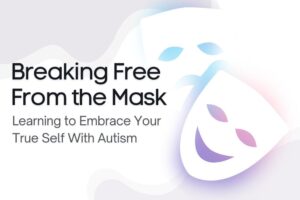
Understanding Masking: Behavioral Camouflage
Masking, also called camouflaging, is a social phenomenon where someone attempts to disguise or suppress specific traits or behaviors that may be deemed unacceptable, inappropriate, or even embarrassing by societal norms.
Masking will vary from person to person, but examples of children with autism masking can include:
-
Forcing or faking eye contact and smiles during conversations
-
Mimicking gestures and facial expressions
-
Hiding or minimizing personal interests
-
Developing scripted or rehearsed responses
-
Disguising stimming behaviors
Some of these behaviors can be seen as good – and in small doses masking is – but it can feel uncomfortable and even exhausting to those on the spectrum, especially for long periods of time.
Masking can become more complex – like studying and mimicking behaviors of neurotypical children of the same age, changing how they dress, adopting certain mannerisms they’ve seen, and more.
The Social Pressure to Mask Symptoms of Autism

We all feel the need to fit in and be a part of the pack. It is human nature. To feel accepted, everyone masks parts of themselves to fit into different social groups.
An easy-to-understand example of masking is Superman’s alter ego, Clark Kent. Superman knows that he is different, and in order to “fit in,” he suppresses his differences and reinvents himself in an unassuming role.
While autism awareness and support are growing, we can still improve understanding and acceptance. According to the National Autistic Society, 79% of people with ASD felt socially isolated because of a lack of public understanding of their diagnosis.
Two psychologists of the University of London ran a survey and found the top five reasons young adults with autism choose to mask:
-
Feeling accepted in social settings
-
Employment
-
Avoid bullying or social ostracism
-
Maintaining and building romantic relationships and friendships
-
Further education
The Effects of Masking
Though there might seem to be benefits from masking, like increased social acceptance and less stigma, these short-term effects are outweighed by the long-term negative effects of masking:
Delayed diagnosis and treatment: Some are so successful in masking their symptoms that autism isn’t identified and diagnosed until later in life. This can lead to more mental health issues and make treatment even harder as behaviors become more ingrained.
Autistic burnout: A term coined by several Portland University psychologists, this form of psychological exhaustion results from continually hiding the symptoms of autism from neurotypical people. Usually, this can require extended periods of quiet withdrawal to recoup their “social battery.”
Emotional dysregulation: Feeling burnt out or going into an emotional breakdown or meltdown are common due to the intense focus and thought processes required to mask effectively for long periods of time.
Increased anxiety, feelings of isolation, and depression: A 2019 study and a 2018 study both confirmed people with autism masking regularly struggled with increased anxiety and depression.
Loss of identity: By masking our identity, interest, and traits, we end up hiding ourselves. A constant state of this can leave someone feeling that they no longer know who they really are. Some have said masking feels like self-betrayal; others have said masking makes them feel they’re deceiving other people.
Taking Off the Mask and Self-Acceptance

Over time, a person may become more aware of their own masking, but it often begins as an unconscious response to social expectations before we even grasp our differences.
Start slow. The first step is recognizing the difference in how you act alone compared to friends or strangers. Of course, we’re more comfortable with friends and family, but this exercise can help you identify what and when to mask.
If you are unsure if you are masking, child psychologist, Dr. Engelbrecht, developed the CAT-Q, an online test to help you determine if and how much masking you are doing on a regular basis. It involves a little math after answering 25 questions, but it is straightforward and has been viewed as a fairly accurate self-assessment source.
The goal here is self-understanding, and, ultimately, self-acceptance. Once you learn to love and accept yourself, it becomes easier for others to do the same.
When and when not to mask is a personal choice and depends on the situation and level of comfort. Working with trained ABA therapists specialized in meeting the needs of neurodivergent individuals can be tremendously helpful.
The positive aspects of dropping the mask:
-
You will have much more energy for putting your brain to more enjoyable uses
-
Increased confidence
-
People liking you for you
-
Reduced social anxiety
Ultimately, it’s up to you to determine which social situations suit you best, when you feel safe to be your true self, and when it’s better to mask. The important thing is to understand your personal limit, and, if you feel open enough, explain to new friends that you have an autism diagnosis and how it may affect social interactions.
In Summary: The Importance of Acceptance and Celebrating Neurodiversity
Masking is a complex and costly social survival strategy for anyone diagnosed with autism.
There are many reasons one with autism may choose to mask their symptoms, and while masking can be helpful in the short-term, masking can have long-term effects on mental health.
The best way to minimize the need to mask is a world in which everyone is accepted for who they are and treated with respect, kindness, and understanding. Celebrate our neurodiversity and the courage to be ourselves.
Sources Cited:
National Autistic Society. Public Understanding of Autism
Cage, E. & Troxell-Whitman, Z. Understanding the Relationships Between Autistic Identity, Disclosure, and Camouflaging
Cage, E. & Troxell-Whitman, Z. Understanding the Reasons, Contexts and Costs of Camouflaging for Autistic Adults
Cage, E., Monaco, J., & Newell, V. Experiences of Autism Acceptance and Mental Health in Autistic Adults
Raymaker, D., Teo, A., Steckler, N., & Lentz, B. “Having All of Your Internal Resources Exhausted Beyond Measure and Being Left with No Clean-Up Crew”: Defining Autistic Burnout



